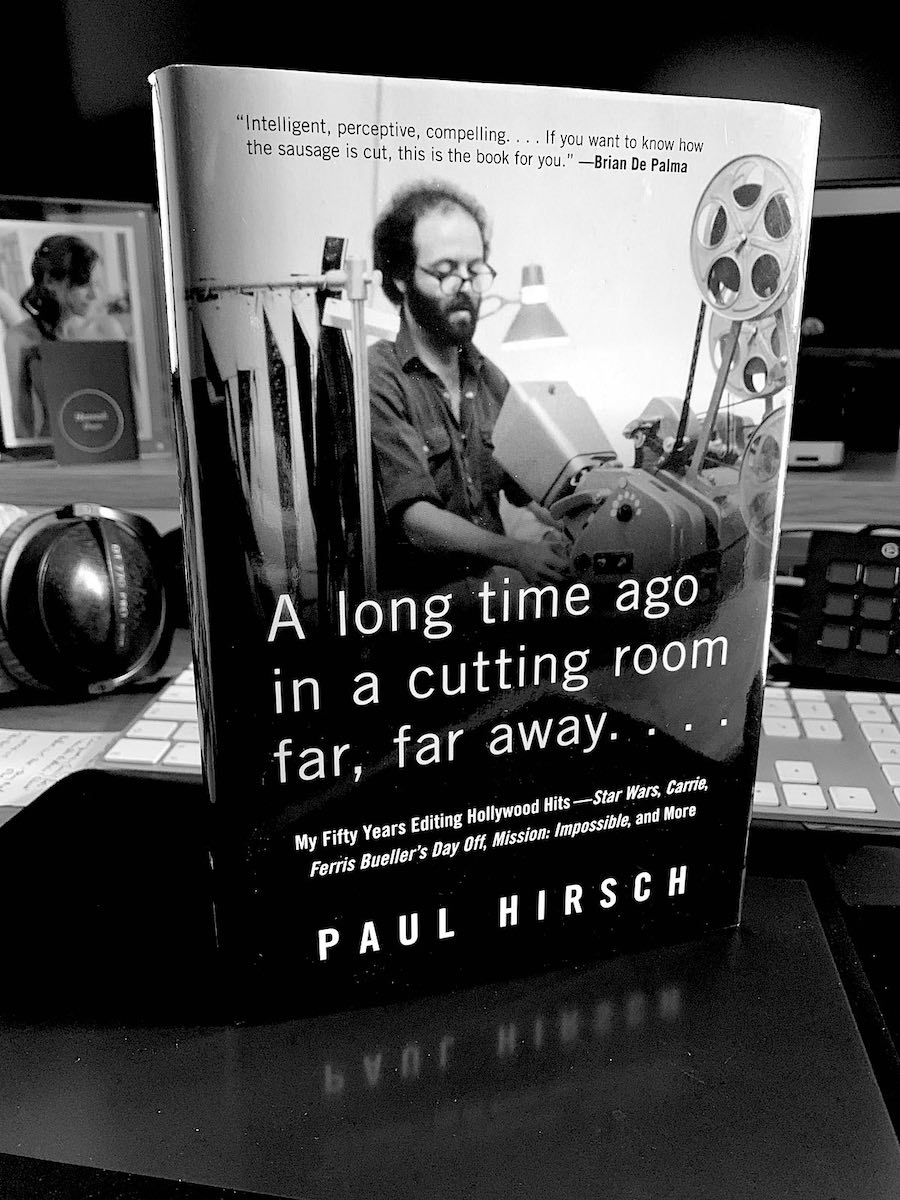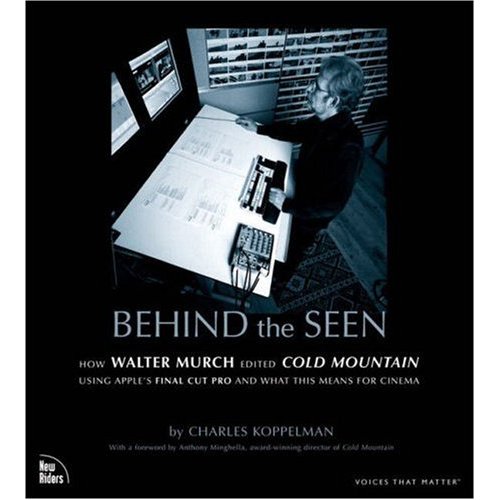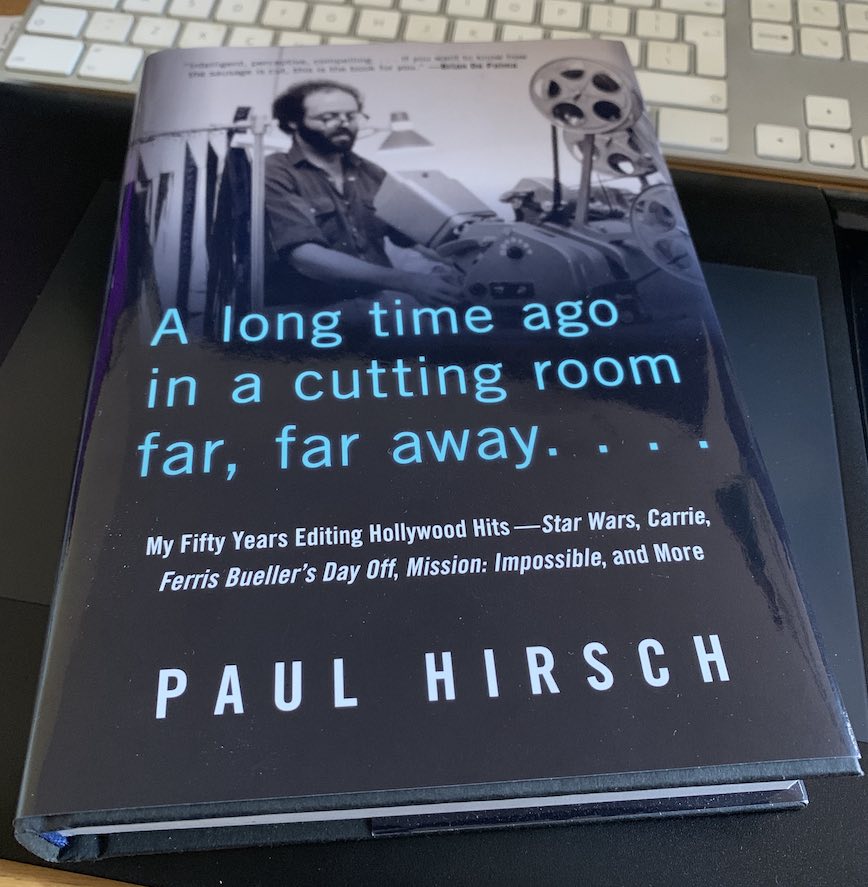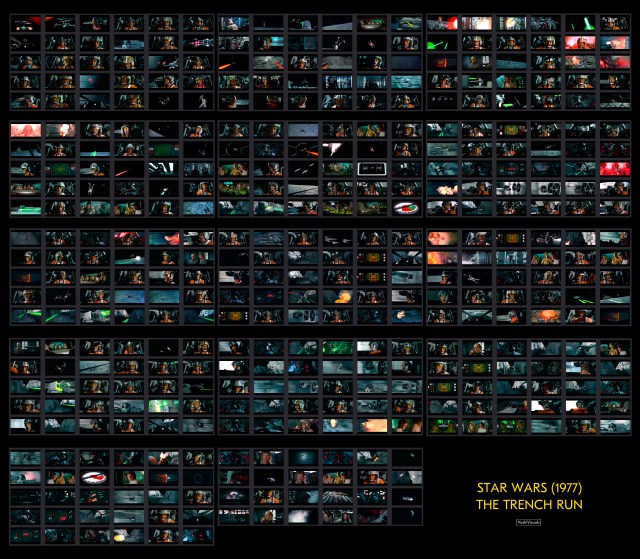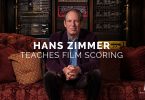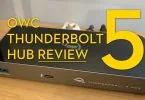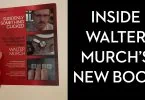Star Wars Editor Paul Hirsch Memoir – Reviewed
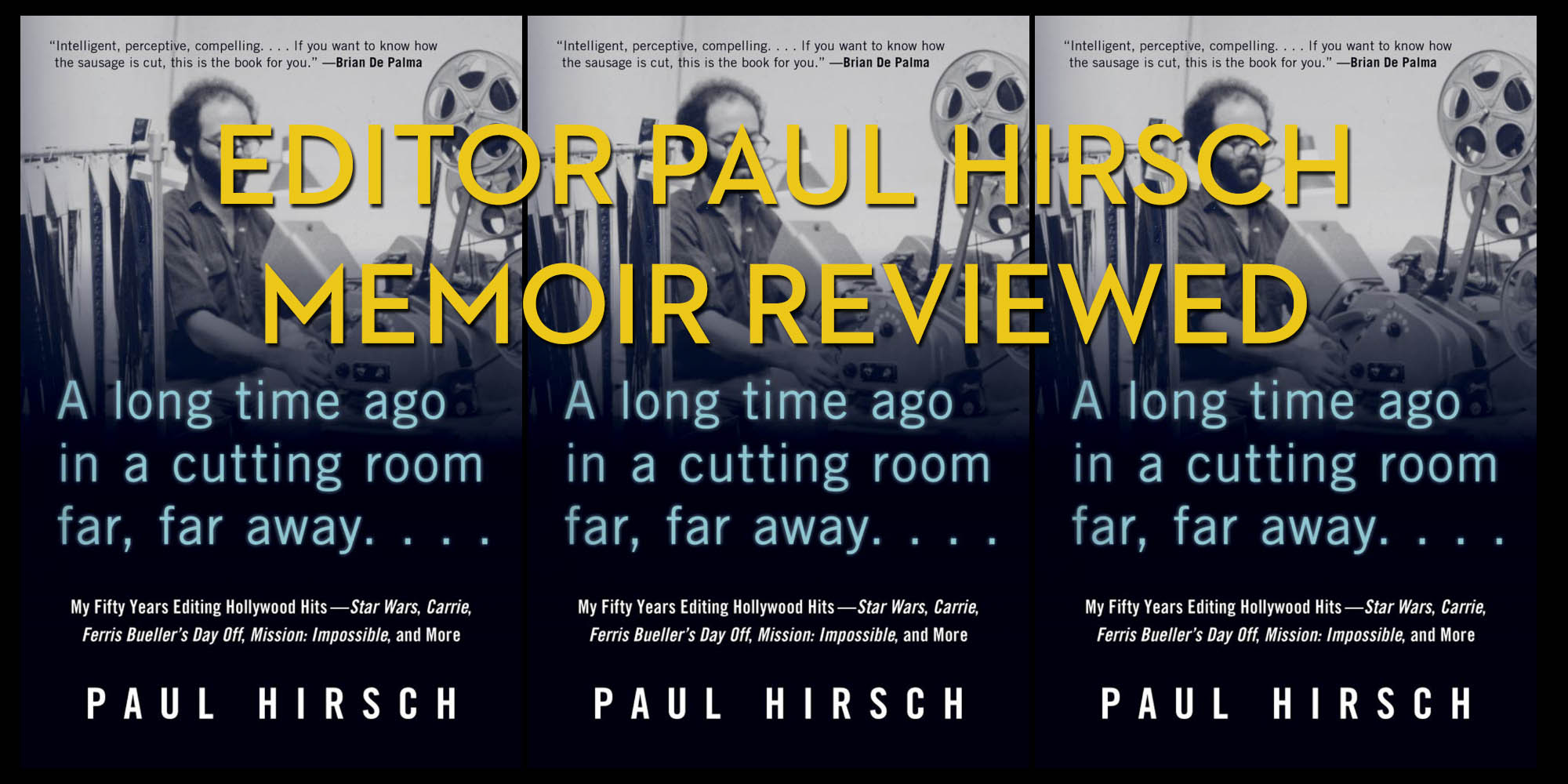
Paul Hirsch’s memoir A long time ago in a cutting room far, far away…. is the most enjoyable book on film editing I’ve read in a very long time.
Many thanks to the folks at the Chicago Review Press for sending me a copy, as an early Christmas present, for the purposes of this review.
Some of the best books on film editing are incredibly helpful for aspiring young editors looking for solid career advice (Jump Cut) others are a font of accumulated craft wisdom and knowledge (The Art of the Cut) whilst others are simply essential guides to storytelling principles (Into The Woods).
Paul’s book delivers an artful blend of all these qualities, whilst maintaining a page-turning pace which draws you into the real life twists and turns of an editor’s career, including handling the inevitable range of hits and flops, dealing with difficult artistic characters and the thorny politics of big money movie making.
This makes A long time ago… a must read for anyone considering embarking on what they hope will be a career in film, as an editor.
So who is Paul Hirsch and what has he cut?
Oh, just a few films you might have heard of such as Carrie, Star Wars, The Empire Strikes Back, Footloose, Ferris Bueller’s Day Off, Planes Trains and Automobiles, Steel Magnolias, Falling Down, Mission: Impossible, Ray and many others.
The book works through his career in chronological fashion, which also really helps to give you a sense of the growth within and trajectory throughout a whole career.
The struggles of breaking in, the importance of creating opportunities, the difficulties of rejection, not to mention a lot of working very hard, moving around the country and some mention of the impact of all that on family life.
One of the huge benefits for any editor reading Paul’s book is that he’s entirely honest about the ups and downs that will naturally occur in the span of a career, especially the commercial and artistic flops that are beyond any single person’s control.
This honesty helps to provide an encouraging sense of what is likely to be ‘par for the course’ and that it’s not all roses in Hollywood, even in the midst of an enviably successful body of work.
He also describes with affectionate detail the path to working his way back to the big time, the importance of maintaining friendships and contacts over the decades, but also the fragility and fallout of the ego’s of some of the creative professionals he’s had the fortune to collaborate with.
Paul’s personal tour through the 70s reminded me of Robert Evan’s The Kid Stays in the Picture and The Final Cut, Dreams and Disaster in the making of Heaven’s Gate, by Stephen Bach both excellent reads on the wild-side of 70s and 80s movie making.
There’s plenty of insider personal anecdotes, funny stories and genuinely helpful nuggets of editing wisdom, certain to engage any working video editor today.
Reading Paul’s look back at his own working life in pictures, you won’t fail to pick up the constant thread of gratitude and genuine affection for those who have laboured for long hours with him in the edit suite and especially to those who opened the door for him and gave him the chance to work hard and keep working, picture after picture, year after year.
A worthy lesson for any working today to cultivate in their existing working relationships – make it fun, remain friends and try to stay in love with the work.
Storyteller and showman, film editor Paul Hirsch narrates the ups and downs of his fifty-year career on the jungle gym of cinema with fascinating inside-the-boiler-room tales of how classic hits and flops were constructed – and deconstructed… – Walter Murch
Hirsch’s writing style and natural sense of storytelling make his memoir a thoroughly enjoyable read and I kept finding myself wanting to pick it up and devour more of it.
It also helps that it’s really nicely printed on great quality paper, with a glossy cover and a strong set of endorsing back cover quotes from J.J. Abrams, Walter Murch and Mark Hamill.
It might seem odd to mention things like the quality of the print and prose but (sadly) it’s not a given that an editing book will be as well presented or even as well edited as this one is and it’s pleasing that this has been so well executed.
Hopefully it’s a sign of more of the same to come, from the publisher Chicago Review Press in the film category!
I enjoyed this book so much I would put it up there with one of my all-time favourite books on the inner world of life as a film editor, Charles Koppelman and Walter Murch’s Behind the Seen – Editing Cold Mountain on Final Cut Pro, which is a similarly delightful blend of personal, historical and technical insights, all wrapped up in solid storytelling.
One thing I would have suggested as an edit (can I do that?) was the removal of the slightly grouchy post script*, as it came across as a complaint against the current trajectory of streaming services and media production, which slightly marred/embittered an otherwise gratitude soaked memoir of a life in pictures.
Buy this book today, honestly you won’t regret it!
Buy A long time ago in a cutting room far, far away…. on Amazon Global Stores
* To clarify: Paul complains about the ‘destructive’ nature of the digital revolution and how sites like Rotten Tomatoes have “reduced a film to a numerical rating” (unlike the star system?), and the fact that the shift towards distribution via streaming services means that many films don’t get a theatrical release, so there is “no box office number from which to infer how well they are received.” Isn’t that reducing a film to a numerical rating too?
You could argue that a box office rating is different in that it illustrates the voice of the people through real human choice; showing up at a cinema and stumping up real money to watch a movie. Rather than simply the aggregate thoughts of a few online movie reviewers. But in the end maybe not much has really changed. People still make films, people still watch films and there’s a way to put a number to the satisfaction of that interaction.
Anyway, lest ye be deceived, the book is excellent, so go read it!
Lessons Learned from Editor Paul Hirsch’s Memoir
I had originally written down a few fistfuls of really great lessons from the book that I thought I’d share in this post, but it feels a little unfair to give all the good stuff away, when you should just buy the book and enjoy it for yourself, first hand!
That said, I thought I’d share just a few of my favourite quotes from the book around specific lessons that every editor should learn as quickly as possible to help them progress in their editorial career as they collaborate with everyone from directors, actors, composers and even studio executives.
We editors can have a powerful impact on our movies. It’s true that we can be overruled, but we often affect the final film in a very personal way… We don’t have power, relative to the director, the producers and the studio executives. But we do have influence.
On Mission: Impossible – Ghost Protocol, I sat in a room with J.J. Abrams, Tom Cruise and Brad Bird. It was liberating.
Since I couldn’t impose my opinion, I felt free to say what I thought and often they would endorse my suggestion. Powerlessness can give you power. – p. xx
There are also plenty of moments of specific editing wisdom, such as Paul’s axiom that ‘pauses are like salt’; just the right amount and in the right places brings out the flavour of the whole meal, but too many will make it inedible.
Pauses are a particular concern. Because films are shot out of sequence, actors may inadvertently pause too frequently.
I am careful to ration the pauses so that the overall pace doesn’t suffer. Pauses are like salt; they must be used in moderation. – p. xvi
There’s also a really great note, which is elaborated on in the book, on cutting to beats, and controlling a shots rhythm and tempo.
I have been asked by some directors to cut on the beats, but, I find this approach too restricting. It is better to have the music animate the action, rather than animate the cuts.
If you cut on the beat, you may lose the action preceding the beat, and that is often the more interesting part of the shot. So I try to cut between the beats. – p.188
As an editor we’re most often locked away in a room by ourselves but there is a really valuable lesson on what to say when you do come into contact with the project’s talent.
Whilst walking on the set of a Brian De Palma film, Paul got chatting the with film’s star, who asked him how the dailies were:
I said they were fine. “When I tighten up some of those pauses, it’ll be perfect.” I thought I had reassured her. The next day Brian came looking for me and was not happy.
“What the hell did you say to my star?” he demanded.
“What do you mean?” I told him what I had said to her.
“I was up half the night trying to talk her down,” he said. “Don’t ever say anything to the actors! You don’t understand. They can’t handle the slightest hint of a problem. You have got to say everything is wonderful.”
I have never forgotten that. – p.63
Paul also talks about the politics and process of working with different kinds of directors.
In the following quote he’s describing the differences between Herbert Ross (Footloose) and Brian De Palma.
“I asked Herbert how he wanted to give me his preferred takes. With Brian, I would sit next to him while we watched dailies and write down when he liked a take a line reading.
“No, just use whatever you think best,” he said. “I have a very good memory. I know what I shot, and if I don’t see it in the cut, I’ll just ask for it.”
“If you liken cutting a movie to driving a fine car, some directors like to sit behind the wheel, with hands-on control. Others, like Herbert, and Brian, to a degree, like to be chauffeured.
I prefer this, since I enjoy the “driving”. It also affords me a great deal of autonomy, which for me is directly proportional to my job satisfaction.
I have worked for directors who prefer to exert total control over the smallest minutiae. It is no fun. Herbert accorded me respect and gave me freedom.”
The editor and director relationship is a complex one. On the one hand you must support and protect the director at all costs – even if it gets you fired by an exec or producer – whilst at the same time you need to offer loyal opposition to make sure the best ideas win.
But in the end you’re there to serve their goals.
In these final two quotes Paul offers some sage advice on how to navigate the endless decision making marathon that is editing.
“Some directors have difficulty making decisions. They operate out of fear that there is a better possibility they haven’t thought of.
My philosophy about decisions is simple.
If there was a huge difference between the two courses of action, the choice would be obvious. If they two possibilities are very close and the choice is not obvious, then choosing one over the other won’t matter much. I prefer making a slightly worse choice to getting hung up in indecision.” – p.106
And…
As I have aged, I have become less insistent. If the director is torn, I tell him or her, “Follow your instinct.” The director has gotten to be a director by using that instinct. And the director has the most on the line.
Directing careers crash and burn with a film’s failure. There is nothing worse than listening to someone else against your own better judgement and having the picture fail.
If you’re going to fail, at least let it happen because of your own choices. (Director) Herbert Ross had an embroidered pillow that read:
ARTISTIC SUCCESS IS DELIBERATE. COMMERCIAL SUCCESS IS ACCIDENTAL. – p.106
Editor Paul Hirsch In Conversation
(Spoiler Alert) Paul was the subject of the first episode of Name That Editor, in which I edited together a montage of trailers from the film’s on editor had cut in chronological order.
It’s really interesting to do, as you see the trajectory of their career play out through the size and quality of the projects the cut, develop over time.
Paul was also interviewed at length as part of EditFest London in 2016, this playlist will give you his whole conversation with journalist Adrian Pennington, in which they cover numerous highlights from his long career. You can also check out this round up of the whole event here.
Paul is also interviewed at length by Matt Feury on the Avid Rough Cut podcast as well as by Steve Hullfish as part of his unmissable Art of The Cut interview series here.
Steve covers a good number of films that Paul worked on including Obsession, Planes, Trains and Automobiles and Mission: Impossible.
Paul is interviewed as part of Cooke Optics excellent YouTube channel in this short video.
Editor Vashi Nedomansky has put together one of his ‘Vashi Frames’, a 414 shot by shot break down of the ‘trench run’ sequence from the end of Star Wars, which Paul edited along side Marcia Lucas and Richard Chew. See it full size here.
Editor Paul Day from the Directors Guild of Canada Ontario chats with Paul for a solid 90 minutes in this editing masterclass.
If after all that you’re still not convinced you need to rush out and buy a copy of Paul’s memoir then you can also read a short extract from it here.

